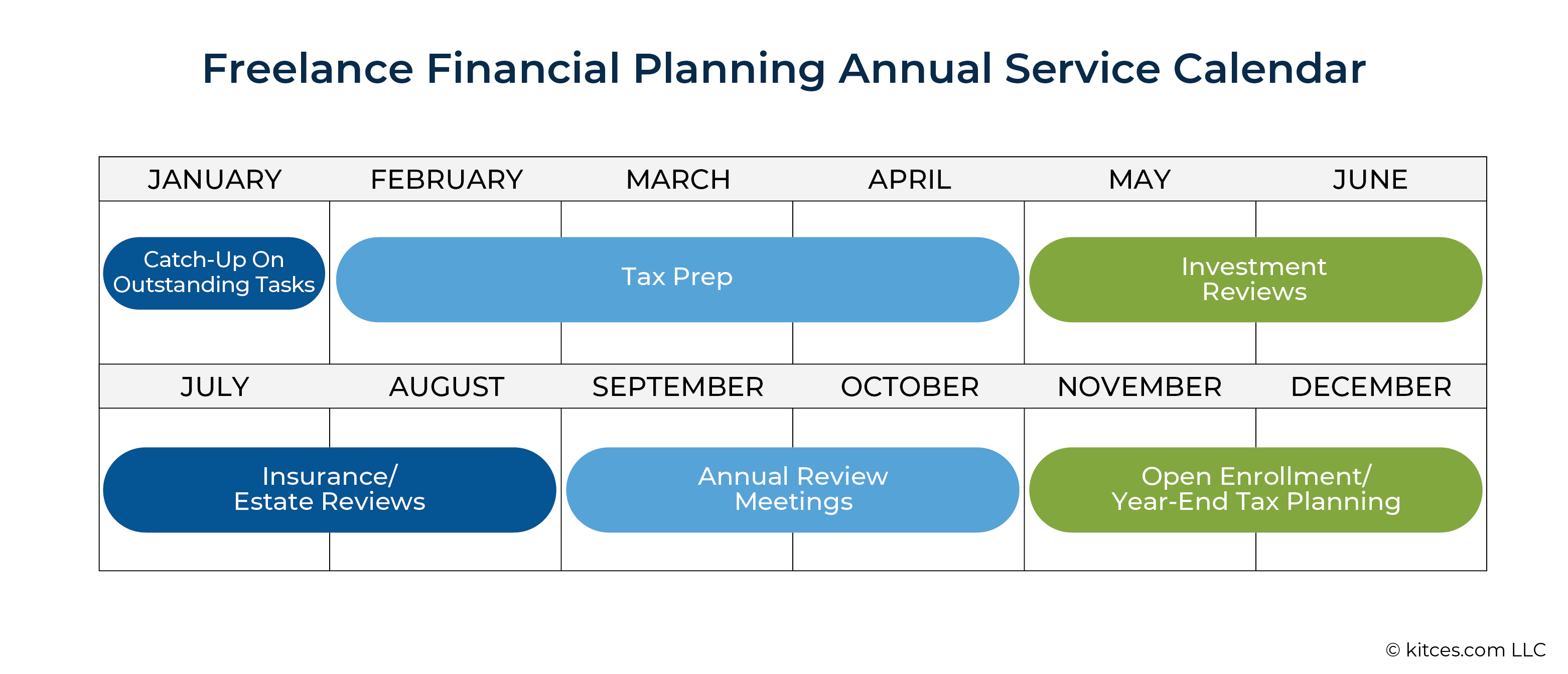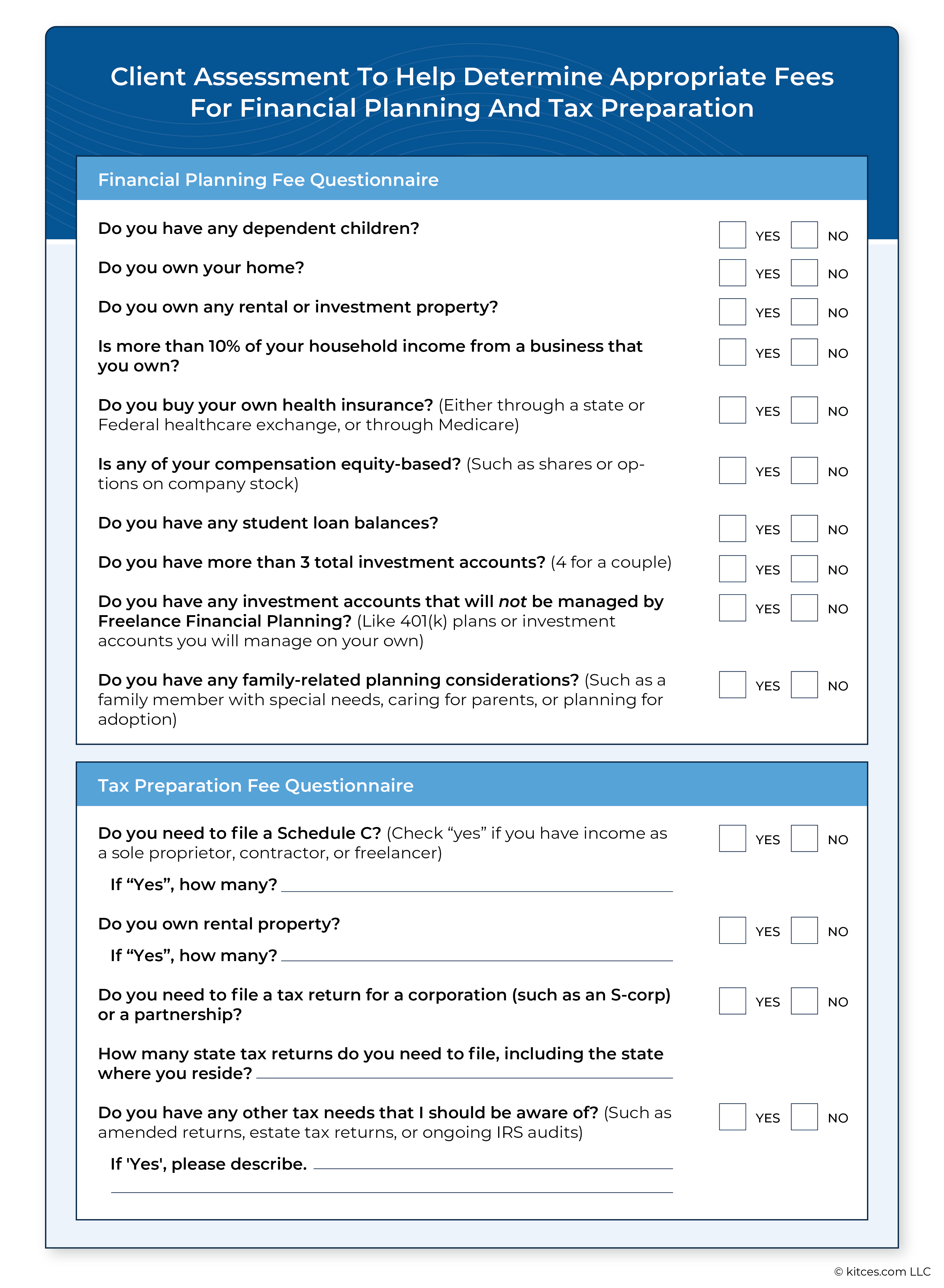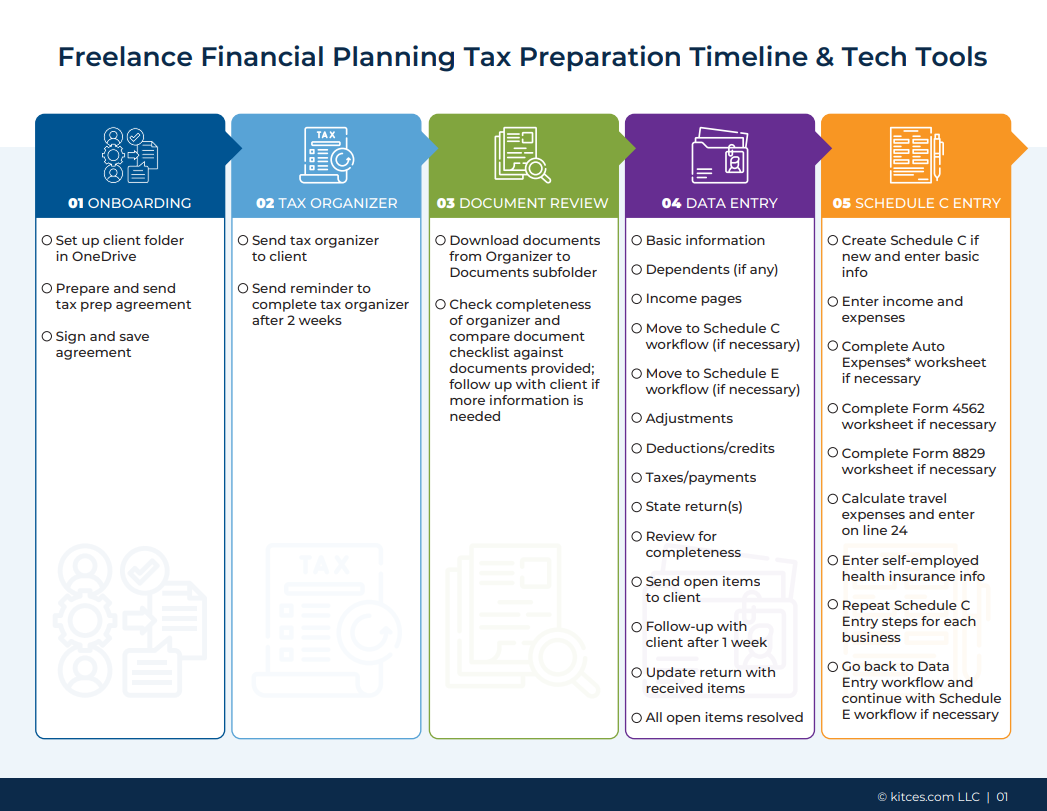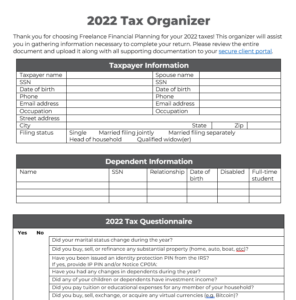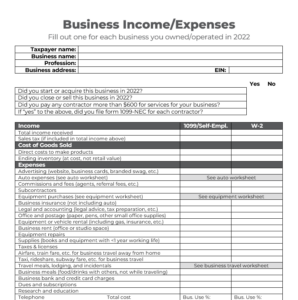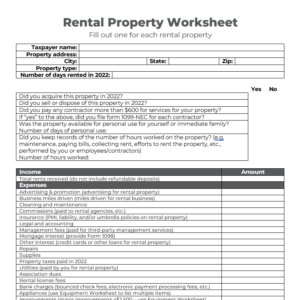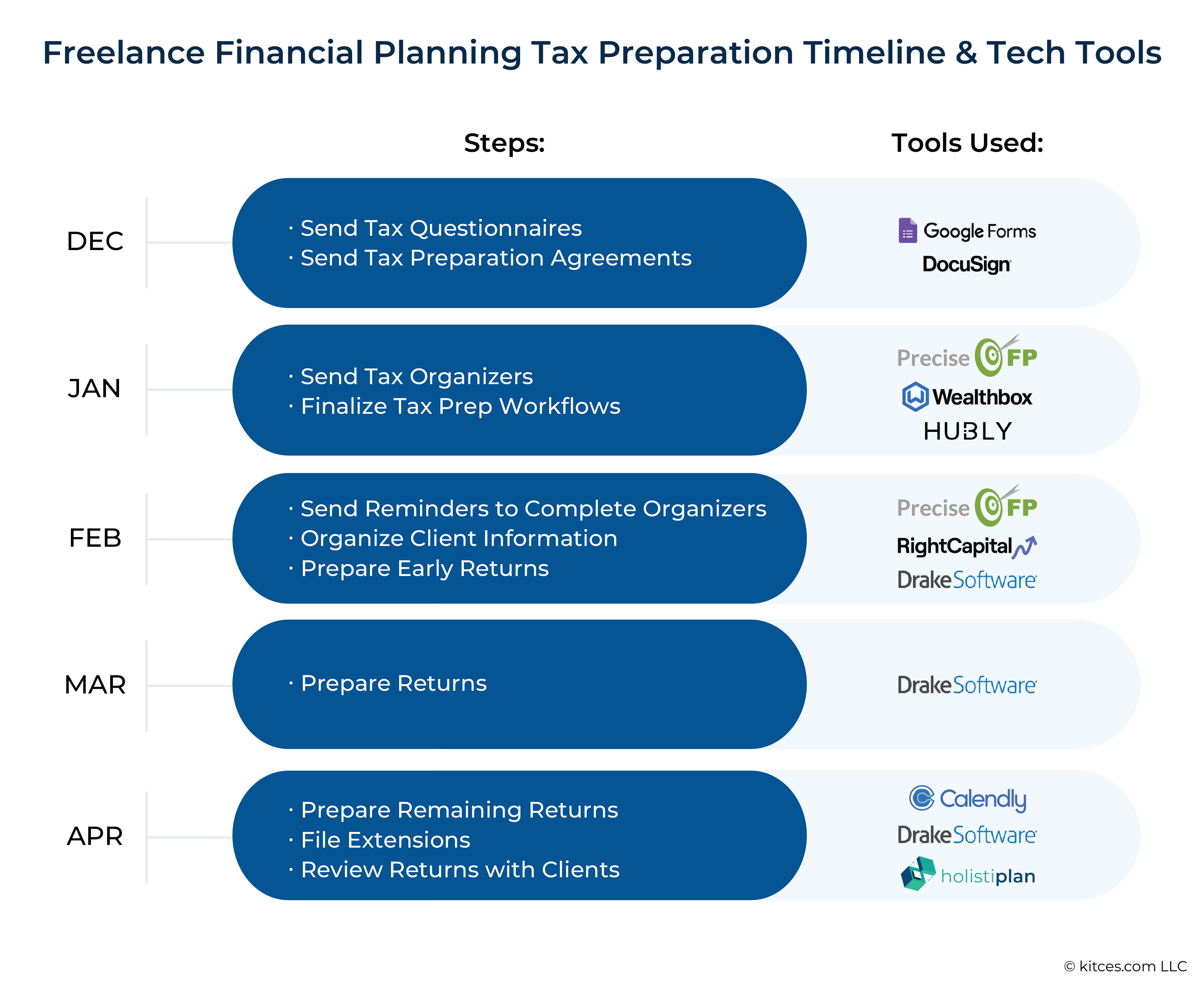Executive Summary
Traditionally, financial advice and tax preparation have existed as 2 related, but separate, services. Besides the fact that many financial advisors don’t hold the necessary credentials (e.g., CPA, EA, or JD) to prepare tax returns and represent clients before the IRS, there has also been the impression that there is simply not enough time for one person to do both. This means that, while many advisory firms have in-house tax preparers (and vice versa), it is relatively uncommon for financial advisors to be the ones doing tax preparation themselves.
For solo advisory firm owners, however, who are largely able to decide for themselves how to provide value for their clients, offering tax preparation can be a way to provide a service that is in demand from many clients (particularly at a time when there is an acute shortage of available tax preparers on the market), while adding to the year-round value the advisor is providing and deepening the client-advisor relationship.
In this post, Kitces.com Senior Financial Planning Nerd Ben Henry-Moreland writes about how he went from being hesitant to offer tax preparation at his solo RIA (given how common it is for tax preparers to work long hours throughout tax season) to embracing it as a core part of the business’ service offering.
One of the keys to this shift in thinking was the realization that, rather than preparing taxes on top of and alongside the ongoing advisory schedule of financial planning updates and client meetings, it could instead occupy its own slot on the ongoing client service calendar. In other words, by clearing space during tax season to focus full-time on tax preparation, it was possible for Ben to contain tax prep work to a reasonable number of hours. Furthermore, similarly structuring the client service calendar for the remainder of the year to focus on specific topics at set times (e.g., investment reviews in the summer, retirement projection updates in the fall, and year-end tax planning in the winter) created enough efficiency through systematizing the ongoing financial planning process that allowed him to fit in tax preparation without reducing any of his other service offerings!
Although it can take as long as a year to get fully set up to prepare tax returns – from obtaining a designation such as the EA to deciding on pricing and software, to developing processes and workflows to streamline tax season as much as possible – advisors may find that many of the tools they use for their advisory business (such as CRM, data gathering, and electronic signature software) can also be used for tax preparation, and that the advisor’s existing knowledge of their clients’ financial and tax situations makes it possible to streamline the process even further (e.g., by tailoring client data-gathering worksheets to focus on the information that is relevant to a client’s tax situation).
The key point is that, offering tax preparation can be seen as a way for solo advisors to use their existing tools and expertise to enhance the year-round value they provide. Which ultimately means that it can be well worth the investment in time and resources given how valuable of a service tax preparation is to many clients!
Not long after I launched my solo RIA firm in early 2018, I faced a problem. My financial planning clients were increasingly asking for recommendations for help with preparing and filing their taxes – as freelance professionals in their early to mid-careers, they were often at the point where the complexity of their tax situations (and the value of their time!) had risen to the point where they were eager to offload the work of tax preparation to a professional.
However, as my clients’ needs for tax preparation were increasing, it was also becoming more and more difficult to find tax preparers to refer them to. Recent years have seen a growing shortage of CPAs, as large numbers of accountants have reached retirement age without a sufficient number of new graduates to replace them. And those who do remain in the industry tend to focus on more lucrative corporate and high-net-worth accounting work, leaving less-affluent taxpayers with few options for professional tax preparation.
The tipping point occurred in early 2020, as COVID-19 disrupted many clients’ lives and introduced even more tax complexity with the introduction of numerous pandemic relief measures when I decided to take matters into my own hands: With so many clients in need of tax preparation and so few professionals to refer them to, I would start preparing returns myself as a way to expand and deepen my client relationships.
Making The Decision To Prepare Taxes As A Solo Advisor
I had been resistant to the idea of offering tax prep services in the past. I knew accountants who worked 80-plus-hour weeks from February through April to churn out hundreds of client returns each tax season, which was something I wanted no part of.
But as I thought about it, the idea of doing tax prep on a more limited scale became more appealing. By offering the service only to my financial planning clients, I could piggyback on some of my existing data-gathering processes to streamline the work of collecting and organizing clients’ tax information. And I was already immersed in tax planning for my clients – from reviewing their returns in the spring to holding year-end tax planning meetings and everything in between – which meant I had already done much of the work of getting up to speed on each client’s tax situation. I also knew there was a market for the service because several existing clients had told me straight out that if I ever decided to start offering tax preparation, they would eagerly take me up on it.
There was just one problem: I had never done tax preparation at scale before. I needed to build out a system to offer it, which included creating new processes from scratch, assessing technology options, deciding how to charge for the service, and most importantly, figuring out how to manage tax preparation alongside my existing financial planning without driving myself to exhaustion.
So as other people took up bread baking, gardening, and home improvement throughout 2020 as they sheltered in place, my own pandemic project was to design and launch a tax preparation service that could work with my firm.
Attaining The EA Designation
Before I started preparing taxes for my clients, I needed to get credentialed to do so. I decided to pursue the Enrolled Agent (EA) designation, which, like being a CPA or attorney, grants a tax professional unlimited practice rights before the IRS (i.e., the ability to prepare tax returns and communicate with the IRS on behalf of clients). The stringent requirements for education to become a CPA (not to mention an attorney) made that route impractical, and pursuing a license to practice accounting or law would have felt like overkill anyway for someone primarily intending to prepare tax returns and give tax advice. (Non-credentialed preparers may also prepare tax returns if they participate in the Annual Filing Season Program, but they have a much more limited ability to represent clients in the event of an audit, which is a valuable service to be able to provide.)
While not being as intensive of a process as qualifying as a CPA or attorney, prospective EAs still must overcome a substantial hurdle in the IRS Special Enrollment Examination (SEE), which is actually a series of 3 separate exams focusing respectively on 1) individual taxation, 2) business taxation, and 3) practicing before the IRS. The first part of pursuing the EA designation, then, was to map out my approach to preparing and sitting for the exams. I started planning in April 2020, with the goal of being enrolled and starting to prepare returns by the spring 2021 tax season.
It's worth noting that at the point when I was preparing for the EA exams, my only experience in preparing tax returns was in doing my own returns. However, in my financial planning career, I spent years reviewing the tax returns of clients and learning about the information they provided about a client’s financial situation. So I wasn’t going in to the exams completely new to the topic, since I already had a good degree of familiarity with many of the tax forms and topics covered. I factored this into the amount of preparation time that I scheduled for myself – if I was coming in with very little working knowledge of tax returns, it would have taken much longer.
On the flip side, although the depth of tax knowledge required to pass the EA exam is similar to that of the required tax curriculum in most educational programs for CFP certification – meaning that those who have gone through the curriculum required to earn their CFP marks should not have trouble handling the material – the breadth of tax information that the exam covers is substantially wider (especially considering that most of the information on practicing before the IRS in Part 3 isn’t included in the CFP curriculum at all). So while many CFP certificants will have at least a baseline level of familiarity with many of the concepts covered from their own CFP education, tackling the SEE most often requires expanding on that knowledge.
The 3 parts of the SEE are offered on a rolling basis from May through February each year, and the exams can be taken in any order. I decided to give myself 2 months to prepare for each exam, meaning if I started studying in April I would be finished by October. (This extra breathing room before the end of the year would prove valuable: Each exam date ended up being rescheduled at least once due to COVID-related testing center closures, so I didn’t end up finishing the last exam until December 1.)
I wanted to tackle Part 3 (Representation, Practices, and Procedures) first, since it is mostly focused on learning the key parts of Treasury Department Circular 230, the document regulating tax professionals who practice before the IRS. Next, I would take on Part 1 (Individuals), and end with Part 2 (Businesses), which I knew would have the most complex material and would likely require the most study time.
With the timeline and order mapped out, I could now plan for how I would study and prepare for the exams. There are multiple options for EA exam prep courses, with Surgent and Gleim being among the most popular, but I settled on the course from Fast Forward Academy, putting extra weight on their large bank of review questions and practice exams since I tend to learn and retain information best by testing my knowledge and getting feedback on the results. By December 2020, I had passed all 3 parts to the SEE – later than I had originally planned (thanks, COVID!) but still in time to start offering tax prep for the 2021 tax season.
Getting Set Up To Prepare Tax Returns
With the exams under my belt, there were a few more steps necessary to be able to start preparing tax returns. Offering tax prep as an EA requires having 3 different ID numbers:
- An EA number, which is issued once the EA candidate has passed all 3 parts of the SEE and undergone a background check, and which must be renewed every 3 years;
- A Preparer Tax Identification Number (PTIN), which is required for anyone who is paid to prepare or assist in preparing tax returns and must be renewed annually; and
- An Electronic Filing Identification Number (EFIN), which is required to electronically file returns with the IRS and is issued after applying as an e-file provider and passing (another) suitability check.
Nerd Note:
Technically, an EFIN is not required since the IRS still accepts paper returns, but many states do require their returns to be filed electronically, and the idea of printing and mailing returns – and ensuring they’ve been received and accepted by the IRS – is a big NOPE for me.
Applying for these numbers requires little more than filling out an online form, but it takes time for the IRS to process everything, meaning it’s best to plan on applying for at least a couple of months before planning to file any client returns.
One more consideration for solo advisory firm owners while getting set up to prepare tax returns is whether to create a separate entity for the tax-preparation side of the business. It’s important to remember that all clients of RIAs are covered by securities laws and regulations regarding client communication, and that any communications with an RIA’s clients can potentially be reviewed by regulators.
It’s often considered a best practice, then, to create a separate tax preparation business to avoid tax preparation clients being scrutinized by RIA regulators, or on the flip side, RIA clients getting caught up in an examination of the tax preparer – which is especially important if there are clients who only hire the advisor for tax prep, and not for financial planning.
In my case, however, I decided to take a more integrated approach where tax preparation was a part of the ongoing financial planning process and only offered to ongoing financial planning clients, which meant it wouldn’t be worth the added complexity of a separate business entity given that there wasn’t a risk of tax-prep-only clients being audited by securities regulators. If I were doing tax preparation outside of my financial planning clients, I would 100% set up a separate entity for doing so.
How I Incorporated Tax Preparation Into My Business
At the same time that I was working toward my EA designation and getting set up to be able to offer tax preparation, I was also planning on how I would offer tax prep. Specifically, I needed to examine what the process would look like, both from my own perspective and my clients’, and how it would interact with the financial planning that I was already doing.
At first, I considered tax prep as a sort of add-on to everything else that I was doing. As such, in that first tax season, I tried to fit the process of collecting clients’ tax information along with preparing, reviewing, and filing returns into the usual schedule of financial planning and client meetings in the first few months of the year. Predictably, this resulted in a time crunch: There simply weren’t enough working hours in the day to add tax prep on top of a ‘normal’ financial planning schedule when I was the one doing all of the work.
As a result, even though my client load was much smaller than most full-time tax preparers, I still had some of the dreaded long work weeks as the 2021 tax season ground on. (And it didn’t help that 2020 was a particularly thorny tax year, with the many CARES Act and other pandemic-related tax provisions requiring tracking down recovery rebate checks, Paycheck Protection Plan loans, sick and family leave days for self-employed workers, etc.) Even though the IRS extended the tax-return deadline to May 17 that year, in practice that just meant pushing back crunch time by a month (since most people wait until the last minute before the deadline to submit their tax information, regardless of when that deadline actually happens).
After that first year, I decided that, going forward, tax season would be devoted only to preparing taxes. At first I was nervous that clients would feel they were being shorted on financial planning if 2 months of the calendar year were blocked off just to focus on tax prep, but it soon dawned on me that this would be an opportunity to truly integrate tax prep into my financial planning service model. Furthermore, it would give me a chance to implement a more regimented client service calendar – something I had long aimed to do but found difficult to implement in the early days of my firm. Just as sections of the calendar would be devoted to planning topics like investments, insurance, and annual reviews, one part of the year would be about all things tax prep:
This was an exciting new perspective! I had been locked into the mindset of what other firms do, who have the resources to hire in-house CPAs or EAs to handle tax prep, or else outsource the whole process, enabling them to do financial planning year-round while taxes are prepared in the background. But as a solo firm owner, I had the power to chart my own course and offer a unique service calendar that slotted tax preparation alongside other services I offered, allowing me to cover the areas that matter to my clients while still being hands-on throughout the process of preparing (and advising on) tax returns.
How I Charge For Tax Preparation
The same shift in perspective that led me to start treating tax preparation as an integrated part of my service calendar also extended to how I charged my clients for preparing their taxes. Where initially my tax preparation fees (as with most firms) were charged as a single fee paid by the client when the return was filed, I decided to combine tax preparation with my clients’ existing monthly financial planning fees – further reinforcing the idea that this was a single, integrated service model.
I floated the idea to several clients before implementing it (mostly as a sanity check to make sure it wouldn’t be met with resistance and require a decision to either backtrack or go forward in spite of client displeasure) and, getting a positive reception, I started planning how to make it happen.
There were a couple of important things I had to consider when combining an annual tax preparation fee with a monthly financial planning fee. The first was to ensure that the fees I was charging my clients aligned with the value of the work I was doing for them. At the time, my existing monthly planning fee was calculated using a short questionnaire assessing the complexity of the client’s overall financial life, but it didn’t contain any questions specific to their tax preparation needs. I needed to add a second section to the fee survey asking questions about their tax situation (such as whether they need to file 1 or multiple Schedules C or E, or if they need to file multiple state tax returns) to calculate the tax preparation component of their fee.
Additionally, I wanted to make sure that even though the new combined tax prep and financial planning fee looked and felt like one integrated fee, it still documented exactly what was being charged for each. State securities regulators want to know what I am charging for financial advice (and that what I say I’m charging clients agrees with what I’m actually charging them), which means it’s important to have the fee calculations clearly delineated in my own records and on clients’ invoices.
By the same token, although tax preparation fees are no longer allowable as itemized deductions on Schedule A, they can still be allowed as deductible business expenses (to the extent they are paid to prepare returns related to the business itself), meaning that it was important to also break out any specific fees for preparing Schedule C or E for my clients who had income from sole proprietorships, partnerships, or rental properties.
So far, the shift from treating tax prep as an add-on to financial planning to providing a service integrated with financial planning has been a success. It has given me more flexibility to craft a client experience that makes my firm stand out to prospective clients who want a single shop for tax preparation and financial planning. However, it’s still an evolving process in figuring out how the 2 sides of the business interact with each other; for instance, I’ve needed to relax my ‘no-financial-planning-meetings-during-tax-season’ rule for clients who are still in the onboarding process in order to avoid losing momentum by pausing the process for 2 months during tax season. Still, this represents to me the ideal of being a solo advisor: the freedom to create and implement a business in my own image, with the flexibility to adapt as I recognize opportunities over time.
The Technology I Use To Streamline Tax Prep
Although taxes is a complicated topic, with an ever-expanding set of Federal and state laws and regulations to stay on top of, tax preparation involves many tasks that can largely be sorted into a standardized, repeatable process. The key to offering tax preparation at scale is to reduce the time spent on actions that can be repeated across most or all of the client base as much as possible, so the tasks that require more of the advisor’s time and expertise – like researching individual clients’ idiosyncratic tax issues – can be given the attention they deserve. This is where technology can come into play, to streamline and/or automate manual and repeatable tasks to bring down the total amount of time needed to complete each return.
The set of technology tools that I use for tax preparation fit broadly within 3 categories, each corresponding to a different step in the tax prep process:
- Collecting the client’s tax information and supporting documents;
- Filling out the necessary tax forms; and
- Having the client sign the return, then filing it with the IRS and applicable state-taxing authorities.
A 4th category of tools comprises those that govern the tax prep process itself and helps me stay organized and on top of where each client is in the process. Which, given the high stakes for completeness and accuracy in preparing tax returns, makes it a crucial category for increasing the speed of tax prep without sacrificing quality.
CRM And Workflows
The most essential tool for me in preparing tax returns is my CRM. This is partially because it houses the essential information for my clients – household details, meeting notes, action items, etc. – but also because it’s the home for my tax preparation workflows.
With many returns being prepared at once – each of which may be at a different step in the process at any given time – it’s necessary to have a system to know the status of each return in order to easily pick it up where I left off. Wealthbox, the CRM I use for my firm, allows me to create custom workflow templates that I can use to systematize the tax preparation process – which I’ve summarized below.
Since I was creating the workflows from scratch, I started by preparing my own tax return as if I were a client, noting each individual step in the process from document collection to data entry to signing and e-filing the return, and turning those steps into a baseline workflow. I then tweaked the workflow and added steps based on what I knew of different client situations. While this didn’t ultimately cover every single step for every client, it got me about 95% of the way there, which is still a whole lot of time savings compared to recreating the process for each return.
Additionally, I use Hubly, a task management platform that overlays my CRM, as a way to consolidate all of my client tasks into a single dashboard. This simply makes it much easier to understand exactly what needs to be done next for each client, which further reduces the time that would otherwise be spent answering the question of what I need to do next.
Without these 2 tools, it would be nearly impossible for me to prepare more than a small handful of returns. Regardless of how streamlined the rest of the process is, it’s extremely difficult to scale tax preparation if it takes a significant chunk of time just to stay organized. Additionally, each workflow acts as a de facto checklist for tax preparation, ensuring that I don’t miss any important steps of entering or reviewing information while preparing returns. I’d be content with being forced to fill out each return by hand as long as I could keep my workflow tools.
Information Gathering
Nothing slows down the tax preparation process more than incomplete information. If a client forgets to send a 1099 Form they received, doesn’t add up their home office expenses, or neglects to list their noncash charitable contributions (or one of many other pieces of information that clients often don’t know to provide), the ensuing back-and-forth to chase down the information can drag out the process.
Each year, most tax preparers send their clients an ‘organizer’, which is essentially a combination questionnaire and document checklist to give the tax preparer the information they need to complete the client’s return. The tricky part about creating an organizer is balancing completeness with length: It needs to be comprehensive enough to encompass what’s relevant to each client’s tax situation but, at the same time, not so extensive that clients are overwhelmed by the sheer amount of information it asks for (particularly if that information doesn’t actually apply to the client’s tax situation).
It's easy to find a tax organizer template with a quick Google search, but what a lot of the templates out there have in common is that they take a ‘shotgun’ approach to information gathering: Nearly every detail of tax information that might possibly apply to any taxpayer is asked for, regardless of whether they’re a business owner, employee, retiree, and so on. In addition to this being potentially overwhelming for clients, I also had no desire to personally read through an entire exhaustive organizer for each client when most of the information would likely be irrelevant.
Here's where my dual role as financial advisor and tax preparer gives me an advantage: Because I already have extensive knowledge of my clients’ financial situations via my ongoing financial planning work, I don’t need to take the shotgun approach to information gathering when it comes to preparing tax returns. Instead, I can create a more streamlined organizer suited to my clients, tailoring the questions and documents to be applicable to each client and minimizing the number of requests for unnecessary information and documents.
Accordingly, I created 3 separate worksheets: 1) A general tax organizer for all taxpayers, 2) a Business Income/Expenses worksheet for Schedule C filers, and 3) a Rental Property worksheet for rental real estate owners (eventually, when I started preparing Form 1065 Partnership returns, I added a separate Partnership organizer as well). This way, I could send the relevant worksheets to each client based on what I already knew about their tax situation, rather than making them sort through pages of questions that had no bearing on their situation.
I’ve made these organizers available for download as Word documents for anyone who wants to use them – these versions are for the 2022 tax year so they would need to be updated for future years but they can serve as a helpful starting point for anyone putting together a tax organizer for the first time.
Initially, I created my organizers in Word and converted them into fillable PDF forms that I could email to clients. Since I use RightCapital for my clients’ financial planning, I had them upload the completed forms and supporting documents to their RightCapital Vault. For the 2023 tax season, however, looking to streamline things even further, I turned my organizer into a dynamic online form using PreciseFP, which, despite being designed as a tool for the data-gathering step of the financial planning process, has proven invaluable as a tool for gathering clients’ tax information as well.
PreciseFP integrates with my CRM (Wealthbox) to automatically pull client information like names, Social Security numbers, and addresses into the form. Additionally, clients can upload supporting documentation like W-2s and 1099s directly as attachments to the organizer, rather than needing to go to a separate ‘vault’ website to do so. And lastly, I can customize the form for each client by selecting specific pages to send to them based on what I already know about them (e.g., sending the page about dependent information for clients who have children, and leaving it out for those who don’t).
The online form also allows me to see the progress each client has made, and to send out automated periodic reminders to those who haven’t completed their organizers yet. It’s been a game changer for me and my clients (who also appreciate not having to download, complete, and then re-upload a PDF organizer), and I was able to do it with a tool that I was already using in my advisory work.
Tax Preparation And Filing
There are a lot of different options for professional tax-preparation software out there, created to suit a wide variety of needs from complicated business returns to simple individual returns at high volume. As someone preparing a couple of dozen returns each year with moderate complexity (but nothing like that of a large corporation), my needs fell somewhere in the middle. After some research, I settled on Drake Tax as the right software for my firm. While it isn’t the most streamlined of the bunch, it can easily handle the needs of my clients, and with a pricing of $345 per year (which includes the first 10 Federal and state returns) plus $29.99 for each additional return, it easily beats the other options in pricing (e.g., Intuit ProSeries, which also has a pay-per-return option, starts at $379 and charges $53 per return, without including any returns in the base price).
If I had other needs, the calculus might be different – for instance, if I offered bookkeeping for clients and needed a solution that integrated with accounting software, if I needed to prepare a large volume of returns, or if I had especially complex individual or business returns to prepare, other options might have stood out more. But for a firm with fewer than a few dozen returns to prepare, and client tax circumstances that range from simple to modestly complex, Drake stood out as not only the most economical option but also the one whose features best aligned with my needs.
Rounding Out The Tax Preparation Process
Much of the remaining software I use throughout the tax prep process consists of tools I already use in my financial planning process. These include:
- Google Forms to send questionnaires about my clients’ tax needs;
- Docusign to get clients’ electronic signatures on tax preparation agreements and on Form 8879 (which authorizes tax preparers to enter the taxpayer’s PIN and e-file the return);
- Holistiplan to analyze and review returns after they have been completed;
- Calendly to schedule tax return review meetings; and
- RightCapital Vault to share and organize clients’ tax return information.
After putting everything in my process all together, this is a high-level overview of how I schedule out my tax prep season and the tools I use for each step:
Lessons I’ve Learned About Tax Preparation As A Solo Advisor
Including tax preparation in my business model has been an iterative process, with each new tax season bringing opportunities to reflect on what worked well (or not so well) in the previous year and make adjustments to improve things for the next year. As such, I’ve learned a few things about how to successfully offer tax prep services as a solo advisor that could be useful for advisors who might be starting their own journeys into tax prep.
Start Early, Set Deadlines, And Stick To Them
Time management is a crucial skill for anyone planning to prepare tax returns. This is true both in the macro sense of how advisors block out their calendars for tax season as described above, as well as in the more micro sense of how they schedule the individual hours of their day to stay focused and sharp enough to provide the minute attention to detail that preparing tax returns often requires.
Some of the most important lessons I’ve learned in my 3 seasons of doing tax preparation have revolved around maintaining – and keeping control over – a schedule that allows me to get through all of my clients’ returns without feeling crunched for time (which in addition to being stressful and tiring, also introduces the possibility of making more mistakes in clients’ returns out of haste or fatigue).
In practice, what this often means is making it very clear to clients not only when the deadlines are for providing necessary tax information, but also what will happen if they don’t make those deadlines. For example, when sending tax organizers to clients, include a specific date by which they should complete the organizer and send any supporting documents, and state (nicely) that not meeting the deadline will likely result in filing an extension of time to file the tax return. It isn’t the end of the world to file an extension, but no one likes to drag out tax season any longer than it needs to be, so this gentle nudge is often enough to keep (most) clients from returning their information late. Most importantly, it sets the expectation that you (the tax preparer) won’t be killing yourself to file the tax return by April 15 if the client doesn’t give you adequate time to do so by returning their information on time.
Notably, while it may be tempting to give clients lots of time to gather their tax information, the reality is that the vast majority of clients will wait until just before the deadline and send everything in then. In other words, the later the deadline, the later the preparer will receive the bulk of their clients’ information and the less time they will have to prepare most of the returns. So setting earlier deadlines – even if they give the client only 1 or 2 weeks to gather their tax information – can take a lot of time burden off of the preparer while not making much difference to the client.
Currently, I give my clients a deadline of February 28 to return their tax information and make it clear that if they do so before the deadline I will most likely be filing their return on time, and if they don’t I will more likely be filing an extension for them (with certain exceptions for items like K-1s, which might not be available until March). Next year I may experiment with moving that deadline up by a week to February 21 to give myself even more time to prepare returns. Most clients’ tax documents are available by February 15 when brokerage firms are required to send their consolidated 1099 statements for taxable brokerage accounts, so, in theory, one could set a mid-February deadline and then have almost a full 2 months to prepare and file returns before the April due date.
Make It Easy For Clients To Make Your Job Easy
Beyond giving clients deadlines for returning information, another important part of streamlining the tax prep process is ensuring that clients have the tools that they need to organize their information and get it sent on time. Based on my own experience, chasing down information from clients – either because they didn’t send in their information on time to begin with, or because they didn’t include information or documents necessary for completing the return – can increase the time it takes to complete each return by up to 50%. A small investment of time and focus in making the process easier for clients (who, after all, hired a tax preparer because they don’t want to bother with all of this any more than they have to) can in turn pay dividends in the form of less time spent preparing each return.
The online tax organizer form, as mentioned above, is one example of how advisors can use their existing tools to make the information-gathering process easier for clients. Sending automated reminders to those who haven’t completed the organizer, which PreciseFP features the ability to do, helps nudge clients toward finishing without requiring the advisor to actively chase them down. And the ability to pre-populate sections of the form with data from the CRM, as well as to choose which sections are sent to each client, ensures that each client will only need to fill out the information that they really need to.
To this last point, it’s worth noting that the benefits of niching for financial advisors also extend to offering tax preparation. Clients with similar financial situations are likelier than not to also have similar tax situations, so advisors with a niche clientele will have a better idea of which tax forms and what other information will apply to their clients.
For example, most of my clients are self-employed workers in knowledge or creative fields with Schedule C business income and expenses, meaning that much of my focus is on gathering and reconciling 1099 Forms with client accounting records, along with collecting information on expenses like software, home office expenses, and computer equipment (much of which can be deducted via the Sec. 1.263(a)-1(f) de minimis safe harbor election). Having a common set of client needs means I can tailor my information-gathering forms to those needs and make it more clear to clients exactly what types of information they need to provide – which ultimately makes my job easier since I’ll be more likely to have all the necessary information available when it comes time to prepare the return.
Stay On Top Of Industry Pricing
When initially deciding how much to charge for tax preparation in 2021, I looked around the industry to see how much it would cost if I were to outsource the process instead. There were 2 reasons for this: first, to ensure that my fees were in line with the industry’s, and second, to give myself an out – if the experiment in offering tax prep didn’t go well in the first year, I could still offer the service while outsourcing the actual tax preparation process, with my clients paying the same amount either way. Providers like Advisor Facing Tax and XY Tax Solutions exist for exactly this reason. At the time, prices for outsourced returns started at around $300 for a basic return and $450 for a self-employed return, increasing from there – so that’s where I set my own rates.
Though I’ve increased my rates since then – I now charge $360 for a basic return, $480 for a self-employed return, and $120 for each additional state return or Schedule C needed – the costs of outsourcing have massively outpaced my own comparatively modest fee increases, caused primarily by the nationwide shortage of CPAs, EAs, and other qualified tax professionals mentioned earlier. A Schedule C return that would have cost $450 2 years ago can now easily cost more than $800 – meaning that not only am I now charging a below-market-rate amount for returns, but I also wouldn’t be able to switch to outsourcing without either significantly increasing the cost for my clients, or else absorbing the extra cost myself.
I’ll likely continue raising my prices gradually to get closer to industry rates while trying to avoid springing a big one-time increase on my clients. But even so, I may never need to charge ‘market’ rates for tax preparation to make it worthwhile for 2 reasons: 1) my ability to use tools and knowledge of my clients from our existing financial planning relationship means a reduction in the work needed to get up to speed on client situations and gather information; and 2) there is a real, though intangible, value in the ‘stickiness’ that tax preparation adds to my ongoing client relationships – the added value that my all-in-one planning and tax prep service creates for clients is reciprocated in the higher likelihood that those clients will stick with me for the long term.
Adding tax preparation was a major milestone in my business. It helped me get better at meeting the needs of my existing clients who were increasingly looking to hand off their tax returns to a professional, and also gave me another point of differentiation for prospective clients who needed both a financial advisor and a tax preparer.
When I started my business, I wouldn’t have thought it was possible to offer tax preparation – I assumed that preparing clients’ taxes would equate to working 100-hour weeks each February through April. But as it turned out, implementing tax prep gave me an opportunity to better structure my client service calendar to ensure I could keep my schedule open for preparing returns during tax season, and ironically has led to a decrease in the total time spent working per client each year, since the yearly planning process is now more structured in a way that I can systematize tasks that were previously done on an ad hoc basis.
Notably, this new structure served me well when I started to ramp up my writing duties for Kitces.com. I have less time for client work now, and fewer clients to handle than full-time advisors do, which has made it all the more important to streamline the process so I can get the most out of the limited time I have to devote to my business. But even with the reduced hours, the value that my clients place on tax prep means I have kept it as part of my core offering – because regardless of whether an advisor spends 4 hours or 40 hours per week on their advisory business, making tax prep a part of the annual client service calendar still leaves room for the advisor to provide value with all their other services throughout the year!


